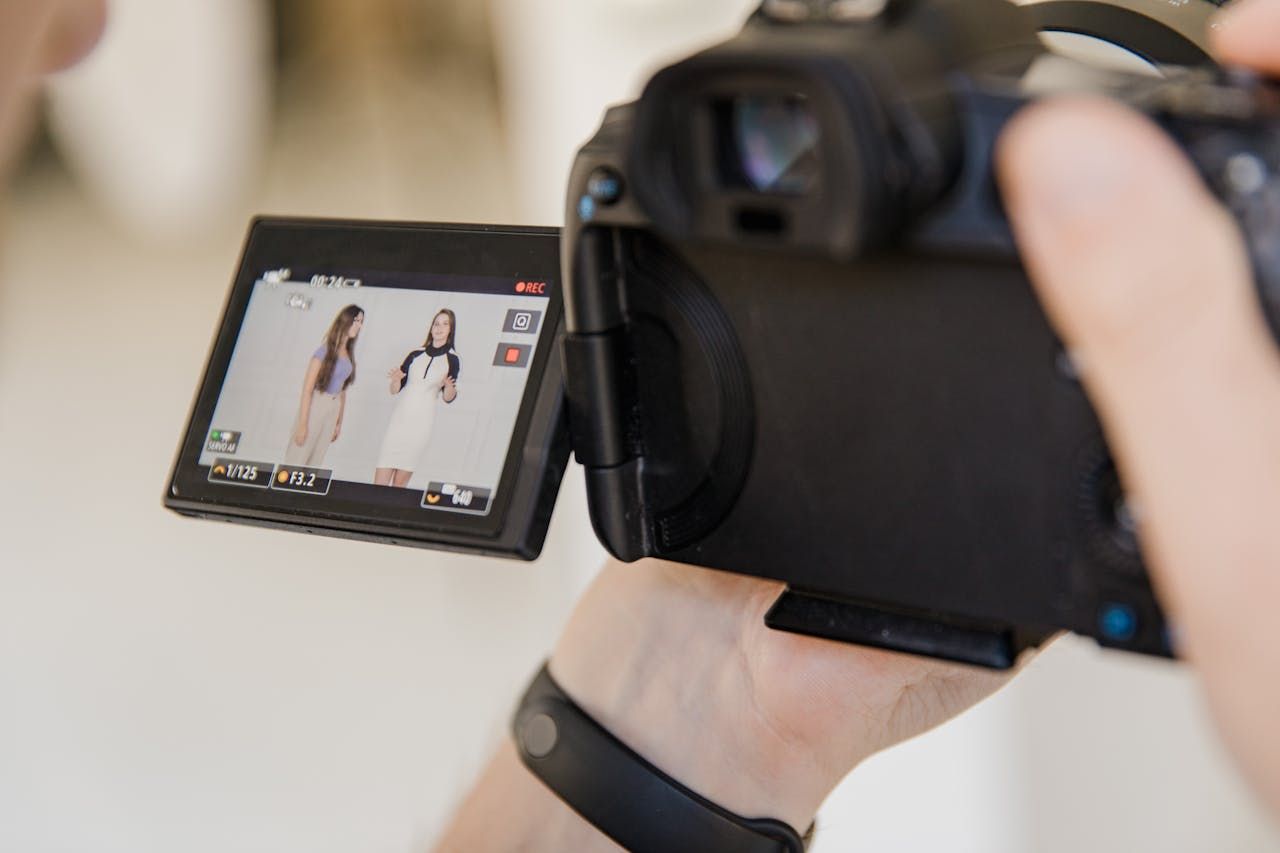Fashion Careers: 2026 Guide to Career Paths, Options & Salary
The fashion industry is vibrant on many fronts, from fashion design to innovative technologies being incorporated into products and their creative processes. Prestige, glamor, and fame also come with the territory. So, many people—especially those with a passion for fashion—are drawn to make a mark on the field and fashion careers. Getting there, however, is a different story. Competition can be cutthroat and success could totally depend on a mix of luck, talent, and who you know.
Even so, it does seem that landing any fashion industry careers is like getting into exclusive clubs. It also does not help that the estimated job growth for fashion designers is at a rate of -4.59% in one projection (Data USA, 2023). The United States Bureau of Labor Statistics (2023) pegs job growth to be only at 3% for the next 10 years. Unsurprising, because one has yet to find fashion degree in any list of the .
But there is a future in fashion and many ways of getting in the door. The fashion industry, like any other, is in need of many diverse skills that are distinct from the design proper. It is disciplinarily diverse and offers different types of jobs that need different skill sets, especially those developed in advanced fashion-related degrees that focus on the business side of things. This is what an MBA degree can bring to the fashion industry.
To give you a more realistic view of the industry and the outlook for available careers in the fashion industry, our research team has compiled relevant public data on the occupations of people with fashion-related degrees and their state of employment across industries. Moreover, the team also compiled information on different career options within the fashion industry itself, jobs that are distinct from fashion design proper but nevertheless very crucial to the discipline as a whole. In this way, those that are aiming for careers in fashion can plot a realistic plan on how to make it in the industry.
Fashion Careers Table of Contents
- Why pursue a career in fashion?
- Fashion Career Outlook
- Required Skills for Fashion
- How to Start Your Career in Fashion for 2026
- How can I advance my career in fashion?
- What is the best path to an online degree for a career in fashion?
- How a Business Degree Can Enhance a Fashion Career
- Alternative Career Options for Fashion
- How do you evaluate the quality of online fashion degree programs?
- How can creative writing skills contribute to a fashion career?
- Are there alternative degrees that can lead to a career in fashion?
- What role do digital innovations play in fashion career advancement?
- How can a graphic design degree online complement a fashion career?
- How can specialized digital marketing certifications boost a fashion career?
- How can an accelerated online communications degree support a thriving fashion career?
Why pursue a career in fashion?
A career in fashion design is held in high regard. One reason for it is that it involves a good deal of self-expression, a sense of autonomy not available in other jobs. Also, a fashion career is viewed as a creative endeavor that can influence societal trends, change, and culture. Hence, it is a magnet for people that want to make a cultural mark. It can also put someone in a position to rub elbows with fashion icons and the movers and shakers of industries, from movies to elite social circles. These, plus the glitz and glamor, are just some of the usual motivations, if not the main ones. The pay is not bad as well. The median pay in 2021 was $77,450 a year, at $37.24 per hour (BLS, 2022). This only gets higher as you move up the rungs of your company, especially when you take on the post of a creative director or manager. Of course, people get into fashion with the hopes of launching their own brands and companies. This, too, when successful can usher not only wealth and financial stability but also a legacy.

Fashion Career Outlook
As mentioned, the career outlook for fashion designers is not so good at the moment. The U.S. Bureau of Labor Statistics (2022) pegs growth at 3% from 2021 to 2031. This is slower than the average across all occupations. During that period, there are only 2,300 projected job openings every year on average. These openings will likely be caused by companies filling in the job vacuum for workers that will retire or find another occupations. Again, another estimate of job growth over the same period is at -4.59%. So, it might be bleaker than the 3% projection. From these two, we could derive the general picture that the job market will be somewhat cutthroat. This is especially when total degrees awarded every year hover around 3,470 and the number grows at a rate of 3.15% annually (Data USA, 2023).
Nevertheless, there are different ways to build fashion careers. The field is disciplinary diverse and requires similar skills that are ubiquitous in other industries such as management, market research, and marketing. So, not all people working in fashion—even fashion designers—have a degree in fashion. In fact, design giants such as Miuccia Prada, Karl Lagerfeld, and Giorgi Armani do not (Salmi, 2021). Also, take note that of the top five most common degrees that working fashion designers have, four have little to do with fashion and art (Data USA, 2023). Although most fashion designers finished school with a visual and performing arts degree (58%), there are those that have degrees in business (11.2%), communications (4.79%), social sciences (4.21%), and engineering (3.59%).
Fashion Beyond Design
It is also good to remember that fashion education is not only about apparel and accessory design. It also has other elements that are essential to running an organization and the business side of things. These, too, are covered in academic degree programs centered on fashion. So, being a fashion designer is not really the only way in and the end of things. The industry is undergoing drastic changes and people with management skills and entrepreneurial vision are also in demand.
One overarching trend among global fashion brands is the sincere push for sustainability and social responsibility. But this is not fully pursued on the international stage, much less accomplished. In a paper titled “Enhancing sustainability in the contemporary model of CSR: a case of fast fashion industry in developing countries" published in the Social Responsibility Journal, the authors argued that “Enterprises in developing countries are practicing CSR mainly in a voluntary and philanthropic fashion to build public image and primarily enhance business profit, not necessarily for social well-being and environmental benefit. Those CSR practices are more of a cosmetic and ‘green-wash’ marketing strategy, undermining the fundamental goal of sustainable development (Nguyen et al., 2020)."
Considering this very obvious point of critique, brands will be in need of a different kind of leadership that follows through on brand promises. So, if you have good leadership skills and are passionate about both fashion and advocacies, then this might be a niche that you can fill.
Required Skills for Fashion
There is a myriad of skills that one needs to possess to be in fashion. A fashion designer does not only do designs per se but also have other responsibilities (BLS, 2023). These include studying fashion trends, procuring samples of fabrics, working with other designers to create prototypes, and even marketing designs to retailers and consumers. As such, they need a wide variety of skills and proficiency in various knowledge areas (see O*NET OnLine, 2023). It is good to note that fashion degree holders also find work away from retail and wholesale fashion. They can get design work in footwear, jewelry, and accessory design. Also, some fashion designers exclusively work on film sets and theaters as costume designers.
Essential Skills for Fashion
- Thinking Creatively. Developing, creating, and designing new ideas, concepts, relationships, and new applications in production and artistic ways.
- Design. Know design principles, techniques, and tools in the production of precision technical models, drawings, and blueprints.
- Production and Processing. Being well-versed in raw materials, their costs, the production process, and quality control processes to optimize the manufacturing and distribution of products.
- Getting information. Acquiring information from observations and other resources from other credible sources relevant to a project or goal.
- Organizing, Planning, and Prioritizing Work. Creating specific plans to organize and prioritize steps to complete work.
- Coordinating with others. Working with and directing other workers and designers in drawing, cutting patterns, and constructing samples.
- Computer-Aided Design (CAD) Software. Be proficient in designing software solutions.
- Graphics and Photo Imaging Software. Be able to use these solutions for design and presentation purposes.
- Writing and Communication. Be able to write informational material for presentations, business communications, and even for marketing.
Apart from essential design and product development-related skills, workers in fashion also need to have the people skills needed to function in their specific work environments. These include having particular attitudes and work styles that fit their job functions (BLS, 2023). They also need to be flexible to adapt to their work contexts. Typically, it is a good mix of freedom with constant interactions with others. Also, fashion designers have an interesting demographic profile, with females making up 83% of the workforce with an average age of 37.9 (Data USA, 2023). This makes fashion a good candidate career for the highest paying jobs for women who reach senior management positions in their respective companies. There are, of course, younger people working in the industry as well. Some of them start work at 17 and the oldest ones were 69 in 2020. So, expect pretty diverse age groups at work.
General Skills for Fashion
- Attention to detail. Being thorough and careful about the details in completing tasks.
- Innovation. The ability for creative and alternative thinking in approaching problems and developing new ideas.
- Initiative. Be willing to take on challenging responsibilities.
- Adaptability/Flexibility. Be open to positive or negative changes of considerable variety at work.
- Independence. Be able to work on their own and be able to make the necessary decisions within their scope.
- Enterprising. Having an enterprising outlook is essential in a job that involves managing, marketing, selling, advising, and negotiating with others. This is especially when designers also interact with clients, other workers, and suppliers.
- Interpersonal Skills. Be able to maintain cooperative working relationships.
How to Start Your Career in Fashion for 2026
Generally, there are no specific certifications or formal education requirements to be a fashion designer (Glassdoor, 2023). In fact, according to a survey of fashion designers, only 24% of respondents state that a bachelor’s degree is required to perform a job in the occupation; 36% stated that an associate’s degree is required while 25% feel that some college experience but no degree is required to perform successfully (O*NET OnLine, 2023). What really counts is talent, skill, and the right attitude and perspective when doing the job. But, of course, having a degree does not hurt. It provides you with job-specific training and may help you jump straight into postings under better fashion career salary brackets.
Invest in the right skills and knowledge
Some college experience, however, is very advantageous. Fashion designers are expected to have a good mix of high-level drawing, design, and sewing skills (Glassdoor, 2023). So, it is highly recommended that aspiring fashion designers take college courses that would help them build these skills. Useful foundational courses include computer-aided fashion design, textiles, history of fashion, figure drawing, and pattern making. Furthermore, one should also build their knowledge of the business side of the industry. One can do this by taking courses such as retail sales promotion, fashion merchandising, consumer behavior, and new product development.
Get some experience
In fashion, there are only a few things that are more valuable than experience. To hone your skills and succeed, the best thing to do is to actually get to work (Glassdoor, 2023). One can do this by taking internships in established design firms or volunteering for a fashion house for events. Also, one can approach personal stylists for mentorship. They can take you under their wings and help you find your place in fashion.
Build your portfolio
Focus on building your skills and your portfolio. A well-composed portfolio will help you showcase your talent, skills, and creativity to potential employers. You can add sketches, patterns, fabrics, and even pictures of your sewn garments. With this, you will exhibit your style, the projects you have been involved with, and your accomplishments.
Just get a degree
Of course, having a bachelor’s degree in fashion is really useful. It provides you with training and the right perspectives about the industry—what to expect when you graduate. Moreover, you also get faster access to those in the fashion community. Of course, this is when you take steps to actively network with teaching staff and alumni that are in the industry. Also, take note that 97% of fashion designers have a bachelor’s degree (Glassdoor, 2023). These might not be directly related to fashion and art but having a degree shows employers that you have the mettle to finish a long-term project. There are even online bachelor’s programs in fashion if you want a good deal of flexibility.
What can you do with an associate’s degree in fashion?
Fashion Design Assistant
This is an entry-level job in the fashion industry (Fashion & Retail Personnel, 2023). Responsibilities include sketching designs, testing materials, testing designs on models, and working with production to see whether a design is feasible (Glassdoor, 2023). Being an entry-level position, a fashion design assistant is expected to increase one’s knowledge of the industry. Also, fashion design assistants have the lowest pay grade among fashion career salary ranges. Even so, they are still expected to be ready to help in developing designs for the company. If you are in this position, treat it as an on-the-job training experience
Median salary: $40,939
What can you do with a bachelor’s degree in fashion?
Buyers Admin Assistant
This is a highly administrative role supporting the assistant buyer, buyer, and senior buyer (Fashion & Retail Personnel, 2023). They make sure that the critical path to the fashion buying cycle runs smoothly. They also rack up samples, maintain the sample library, attend fit sessions, research competitors, and create fashion trend boards for meetings. Aside from typically having high fashion jobs salary tiers, buyers also get travel perks for meeting with suppliers and even for inspiration trips.
Median salary: $41,591
Junior Assistant Designer
If you have performed well in school, including having a good internship and volunteer experience, your bachelor’s degree in fashion can help you land a job as a junior assistant designer. Typically, however, this post is earned after one to two years of job experience as a fashion design assistant. Responsibilities include researching fashion trends, sourcing fabrics and trims, and assisting in the design of fashion rangers (Fashion & Retail Personnel, 2023). They are also expected to be highly capable of using Photoshop, InDesign, and Illustrator, among others (Glassdoor, 2023). Of course, they should have good hand-drawing skills.
Median salary: $41,504
Fashion Graphic Designer
They create all the prints, graphics, and placement prints for different types of clothing. Depending on company size and structure, fashion graphic designers may also be assigned to great graphics and layouts for marketing materials such as billboards and social media posts (Glassdoor, 2023). They also help in researching fashion trends, sourcing prints, and approving strike-offs. Of course, they are expected to be highly proficient at drawing by hand and be excellent at using CAD software, including Illustrator and Photoshop.
Median salary: $52,104
How can I advance my career in fashion?
Again, experience is really the engine for career advancement in fashion. Academic qualifications can have some pull but actual work capabilities, talent, and creativity have more weight. Moreover, having graduate degrees can also allow you to leapfrog entry-level positions and jump right into senior or even management roles. Also, as graduate schoolwork and experience will expose you more to the business aspects of the fashion business, you will also likely be able to land junior to middle management administrative jobs. And what’s a doctorate degree but a specialization that just might land you a C-suite position. But, of course, experience is still required.
Postgraduate need not be costly. You can look for scholarships and grants, or simply go for some of the cheapest MBA online programs to start with.
What can I do with a master’s in fashion?
Buyer
Produces a profitable range that fits the brand’s identity and target customer preferences (Fashion & Retail Personnel, 2023). Works closely with other departments, from trend concepts to in-store visuals. Fashion buyers also make sourcing and inspirational trips. They are expected to be in the know when it comes to fashion trends; and, preferably, be ahead of them to give their brand a boost.
Median salary: $88,005
Junior Merchandiser
They are solely responsible for the sales and stocks of a fashion range (Fashion & Retail Personnel, 2023). They work under the Merchandiser but also work with upper management to help plan future fashion seasons to set out how much stocks are needed. They review sales performance and manage the work of Assistant Merchandisers and Merchandise Admin Assistants.
Median salary: $50,866
What can I do with a doctorate in fashion?
Merchandise Director
Streamlines the organizational and merchandising strategies across product areas. Ensures the brand delivers financially viable cohesive ranges. They work closely with the Finance Director, Buying Director, and Retail Director, among other senior members to make sure all fashion offerings deliver a healthy profit (Fashion & Retail Personnel, 2023).
Median salary: $97,292
Chief Executive Officer
Chief Executive Officers create and implement design strategies to push the company to new heights (TRUiC, 2018). They lead fashion trends research and work with senior management to find ways to increase profitability and brand prestige. Also, they make crucial hiring decisions to strengthen the company’s workforce and build competitive competencies. Usually, to get hired in this position, one has to have more than 15 years of experience in the industry and a minimum of five years in leadership roles.
Median salary: $407,102
Which certification is best for fashion?
Fashion has many concentrations that range from design to the business side of the industry. As such, there are many certificate programs that help students develop specific skills needed for an aspect of the trade. They include certifications for sewing machinists, jewelry design, costume design, fashion make-up, and, of course, fashion design. You can avail of these in local community colleges or universities to gain more points of entry to fashion career paths.
What is the best path to an online degree for a career in fashion?
Pursuing an online degree is a flexible and cost-effective way to kickstart or advance your career in the fashion industry. Many accredited programs now offer specialized tracks tailored to different facets of the fashion world, such as design, marketing, and business. These programs equip students with essential skills, including computer-aided design (CAD), merchandising strategies, and sustainability practices—aligning with industry demands.
One advantage of an online degree is the ability to balance education with work or personal commitments. By enrolling in an accredited online bachelor degree program, you can gain the credentials needed to enter or pivot within the fashion industry without disrupting your current lifestyle. These programs often feature a curriculum designed by industry professionals, ensuring relevance and practical application.
Moreover, online platforms frequently provide networking opportunities, connecting students with industry experts, alumni, and peers globally. This exposure can be invaluable when seeking mentorships or job placements. With advancements in online education technology, earning a degree remotely is not just a practical option but a strategic step toward achieving success in the highly competitive fashion industry.
How a Business Degree Can Enhance a Fashion Career
While many aspiring fashion professionals pursue degrees in design and visual arts, business degrees also offer a valuable foundation for a successful career in the fashion industry. Fashion is not just about creativity and design; it’s also about strategy, management, marketing, and financial planning. A solid understanding of business principles can provide fashion professionals with the skills they need to excel in various roles that bridge the gap between creative design and commercial success.
With a business degree, you can pursue roles such as fashion marketing manager, merchandise planner, buyer, or fashion business owner. These positions require knowledge of business practices, consumer behavior, product pricing, and inventory management. A business degree equips professionals with the expertise needed to analyze market trends, make strategic decisions, and run successful fashion enterprises.
For those looking to enter the fashion industry but with a focus on the business side, pursuing a business degree offers a flexible and strategic pathway. Additionally, it can open up opportunities for higher-paying roles and leadership positions, which are essential for career advancement.
If you're interested in exploring business degree options that could complement your aspirations in the fashion industry, consider looking into the easiest business degree programs. These can provide a quicker route to gaining foundational business knowledge that supports your career goals in the dynamic world of fashion.
Alternative Career Options for Fashion
Careers in the fashion industry are not really in demand. But, fortunately, skills that you get from fashion programs—degree or certificate—are translatable to other careers (BLS, 2022). You can think out of the box also, for instance, getting online accounting courses will help to get you a finance position in this industry.
Using public data from the most recent reports from credible sources, our research team has compiled some of the best alternative job options for fashion degree holders. Most of them, of course, are related to art and design careers. They include:
Fashion Careers: A Competitive Landscape
The fashion job market is quite competitive, especially for fashion design posts. As discussed, the job outlook for fashion designer jobs is very bleak. So, fashion design graduates are likely to find other means to make a living rather than just focus on fashion careers.
But the fashion industry is also quite diverse. Like any other, there are different skills involved to make an organization successful. These include management, analytic skills, financial skills, and relationship-building skills. And these, too, receive focus in fashion degree programs. They are also available via 5-week online college courses. Having skills and experience in these areas can get you into the fashion industry, albeit not in a design capacity at first. But, if you really have the mettle, talent, and patience to build a convincing body of work, then getting a design job is just a matter of time.
Also, with the rising tide of the entrepreneurial spirit in the zeitgeist, it is likely that more brands and businesses will pop up that require design skills, specifically fashion design skills. You can also take online colleges business programs if you’re seriously pursuing putting up your own shop or brand. Riding this wave, given you have the expertise and experience, you too can come up with a brand of your own someday.
But let reality sink in first. The job outlook, based on the numbers, is not great. The job market is cutthroat. And, many designers and other fashion professionals already have a head start. So, the road to careers in fashion can be long and arduous. You need to prepare for this and set your expectations straight.
Exploring Culinary Arts as a Creative Alternative
Another promising avenue for individuals with a creative flair similar to fashion is the culinary arts. While the two industries may appear distinct, both emphasize innovation, craftsmanship, and self-expression. The culinary field allows professionals to merge artistry with practical skills to create unique, memorable experiences for their audience. Similar to fashion, culinary arts also offer various opportunities for entrepreneurship by enabling talented individuals to establish their own brands, be it a restaurant, catering business, or food product line.
For fashion enthusiasts considering a pivot or an additional skillset, culinary arts can complement a creative career. The hands-on nature of culinary education promotes quick adaptation to rigorous industry demands, a trait also valued heavily in fashion roles. Moreover, there’s significant industry overlap in areas such as event planning and luxury lifestyle branding—making culinary knowledge an asset for those aiming to work in broader creative or lifestyle sectors.
To explore if this path aligns with your ambitions, it’s worth understanding how much is culinary school. This resource provides critical insights into tuition costs and what to expect from a culinary degree program, which could serve as a stepping stone to a fruitful creative profession.
How do you evaluate the quality of online fashion degree programs?
When selecting an online fashion degree program, it is essential to review accreditation and industry recognition to ensure the curriculum meets current market standards. Consider evaluating course content for alignment with emerging industry trends and technological advancements, as well as faculty credentials and the program’s history of alumni success. Assess available career support services, including internships, mentorship opportunities, and networking events, to establish a pathway to professional growth. Moreover, compare costs, flexibility, and the balance between theoretical and practical learning elements. For programs that offer robust academic rigor while maintaining affordability, refer to MFA online as a resource.
How can creative writing skills contribute to a fashion career?
In an industry where storytelling and brand narrative are critical, integrating creative writing skills can significantly enhance a fashion professional’s effectiveness. Mastery in creative writing helps articulate compelling brand messages, craft engaging marketing content, and develop persuasive communication strategies. This skill set is particularly valuable when differentiating a brand in a competitive marketplace and when leveraging platforms where content drives consumer engagement. For professionals aiming to blend creative writing with fashion, considering programs that offer the cheapest bachelor's degrees in creative writing can provide a strong foundation. This interdisciplinary approach supports enhanced digital marketing, effective public relations, and innovative content creation, all of which contribute to sustained career growth in fashion.
Are there alternative degrees that can lead to a career in fashion?
While many aspiring fashion professionals pursue degrees in design and visual arts, other degrees can also lead to a successful career in the fashion industry. For instance, degrees in education can provide a foundation for careers in fashion education, such as teaching fashion design or merchandising. Additionally, degrees in business, marketing, or communications can be beneficial for roles in fashion management, branding, or public relations. It's essential to consider the various degree options available and how they can be applied to the fashion industry.
What role do digital innovations play in fashion career advancement?
In today’s interconnected market, digital tools and platforms redefine how professionals build and showcase their careers in the fashion industry. From creating dynamic online portfolios to leveraging social media for networking and brand development, technology enhances visibility and opens up new growth opportunities. Furthermore, advancements in data analytics and e-commerce provide critical insights into consumer trends, enabling individuals to align their skills with market demands. Gaining expertise in digital marketing, online merchandising, and emerging fashion technologies is increasingly essential. For those seeking formal education in this evolving field, pursuing a bachelor degree in fashion business can provide tailored skills that bridge creative design and modern business strategies.
How can a graphic design degree online complement a fashion career?
Integrating advanced visual communication skills through digital design can elevate a fashion professional’s creative portfolio and business acumen. Graduates equipped with expertise in graphic design can enhance branding, marketing collateral, and social media presence, which are crucial in today’s competitive landscape. For instance, mastering digital composition and layout can improve the effectiveness of visual merchandising and promotional campaigns. Enrolling in a graphic design degree online program provides targeted training that bridges creative expression with technical proficiency, ultimately supporting innovative storytelling within the fashion industry.
How can specialized digital marketing certifications boost a fashion career?
Specialized digital marketing certifications provide a competitive advantage by equipping fashion professionals with advanced skills in online branding, audience engagement, and analytics-driven decision-making. These programs emphasize practical strategies that integrate seamlessly with creative design—enhancing a professional portfolio and broadening career opportunities in roles that bridge creative and strategic business functions. Completing accredited programs, such as the fastest online master degree social media marketing, signals proficiency in leveraging digital platforms and data insights. This certification can lead to roles focused on digital content creation, e-commerce optimization, and innovative consumer outreach strategies, thereby and effectively complementing traditional fashion education with modern market techniques.
How can an accelerated online communications degree support a thriving fashion career?
By integrating strategic communication skills into a fashion career, professionals can enhance both internal brand coherence and external market influence. An advanced communication focus enables precise storytelling, effective stakeholder engagement, and confident negotiation skills—crucial attributes in a competitive and trend-driven industry. Pursuing accelerated online communications degree programs provides targeted training in digital content creation, public relations, and strategic messaging, ultimately empowering fashion professionals to articulate their vision and drive innovation across diverse roles.
Key Insights
- Competitive Industry: The fashion industry is highly competitive, with an estimated job growth for fashion designers pegged at only 3% from 2021 to 2031, which is slower than the average for all occupations. This means landing a job in fashion design can be challenging.
- Diverse Career Paths: Despite the competition in fashion design, the industry offers various career paths requiring different skill sets, such as management, marketing, and market research. This diversity allows individuals with varied backgrounds to find roles within the industry.
- High Regard for Fashion Careers: A career in fashion is often associated with creativity, self-expression, and the ability to influence cultural and societal trends. This allure attracts many aspiring professionals to the field.
- Significant Salaries: The median pay for fashion designers in 2021 was $77,450 per year. Other roles, such as purchasing managers, buyers, and merchandisers, also offer competitive salaries, making the industry financially rewarding.
- Educational Background: While many fashion designers hold degrees in visual and performing arts, other common degrees include business, communications, social sciences, and engineering. This indicates that a diverse educational background can be valuable in the fashion industry.
- Essential Skills: Key skills for fashion professionals include creativity, design principles, knowledge of production processes, proficiency in CAD software, and strong communication abilities. These skills are crucial for success in various fashion industry roles.
- Advancement Through Experience: Gaining experience through internships, volunteer work, and entry-level positions is vital for career advancement in fashion. Building a strong portfolio and networking within the industry are also essential steps.
- Graduate Degrees and Certifications: Advanced degrees and certifications can provide a competitive edge and open up opportunities for higher-level positions in management and specialized areas within the fashion industry.
FAQ
- What is the job outlook for fashion designers? The job outlook for fashion designers is relatively stagnant, with an expected growth rate of 3% from 2021 to 2031. This is slower than the average growth rate for all occupations, making the industry highly competitive.
- What are some alternative career paths in the fashion industry besides fashion design? Alternative career paths in the fashion industry include roles in management, marketing, market research, merchandising, buying, fashion writing, and costume design for film and theater. These positions require various skills that can be acquired through education and experience.
- What educational background is beneficial for a career in fashion? While many fashion designers have degrees in visual and performing arts, degrees in business, communications, social sciences, and engineering are also common among fashion professionals. This diversity in educational backgrounds highlights the interdisciplinary nature of the industry.
- What essential skills are needed for a career in fashion? Essential skills for a career in fashion include creativity, knowledge of design principles, understanding of production processes, proficiency in CAD software, strong communication abilities, attention to detail, innovation, and interpersonal skills.
- How can I gain experience in the fashion industry? Gaining experience in the fashion industry can be achieved through internships, volunteer work, and entry-level positions. Building a strong portfolio, seeking mentorship, and networking within the industry are also crucial steps for career advancement.
- What roles can I pursue with an associate’s degree in fashion? With an associate’s degree in fashion, you can pursue entry-level roles such as fashion design assistant or buyers admin assistant. These positions involve supporting senior designers or buyers and gaining valuable industry experience.
- What are the benefits of pursuing a bachelor’s degree in fashion? A bachelor’s degree in fashion provides comprehensive training in design, business, and marketing aspects of the industry. It opens up opportunities for roles such as junior assistant designer, fashion graphic designer, and buyers admin assistant, which offer competitive salaries and career growth potential.
- How can I advance my career in the fashion industry? Advancing your career in the fashion industry involves gaining experience, building a strong portfolio, and pursuing advanced degrees or certifications. Networking and developing business skills can also help you move into higher-level positions or management roles.
- What are the highest-paying jobs in the fashion industry? Some of the highest-paying jobs in the fashion industry include roles such as creative director, fashion design manager, buying director, merchandise director, and chief executive officer. These positions require extensive experience and advanced skills.
- Which certifications are beneficial for a career in fashion? Beneficial certifications for a career in fashion include those in fashion design, costume design, jewelry design, and fashion make-up. These certifications help develop specific skills and increase employability in specialized areas of the industry.
References:
- Bureau of Labor Statistics. (2022, April 18). Fashion designers. BLS.
- Bureau of Labor Statistics. (2022, September 8). Fashion designers: Similar occupations. BLS.
- Data USA. (2023). Fashion & apparel design. Data USA.
- Data USA. (2023). Fashion designers. Data USA.
- Fashion & Retail Personnel. (2023). Junior assistant designer. Fashion and Retail Personnel.
- Fashion & Retail Personnel. (2023). Buyers admin assistant. Fashion and Retail Personnel.
- Fashion & Retail Personnel. (2023). Buyer. Fashion and Retail Personnel.
- Fashion & Retail Personnel. (2023). Junior merchandiser. Fashion and Retail Personnel.
- Fashion & Retail Personnel. (2023). Merchandise director. Fashion and Retail Personnel.
- Glassdoor. (2023). How to become a fashion designer. Glassdoor.com.
- Glassdoor. (2023). Assistant designer career. Glassdoor.com.
- Glassdoor. (2023). Fashion design assistant career. Glassdoor.com.
- Glassdoor. (2023). Fashion graphic designer career. Glassdoor.com.
- Nguyen, H. T., Le, D. M., Ho, T. T., & Nguyen, P. M. (2020). Enhancing sustainability in the contemporary model of CSR: A case of fast fashion industry in developing countries. Social Responsibility Journal, 17(4), 578-591. Emerald.
- O*NET OnLine. (2023). 27-1022.00 Fashion designers. O*NET.
- Salmi, N. (2021, May 21). 14 designers who never got fashion degrees. L’Officiel USA.
- TRUiC. (2018, December 13). Clothing line CEO job description. howtostartanllc.com.


































